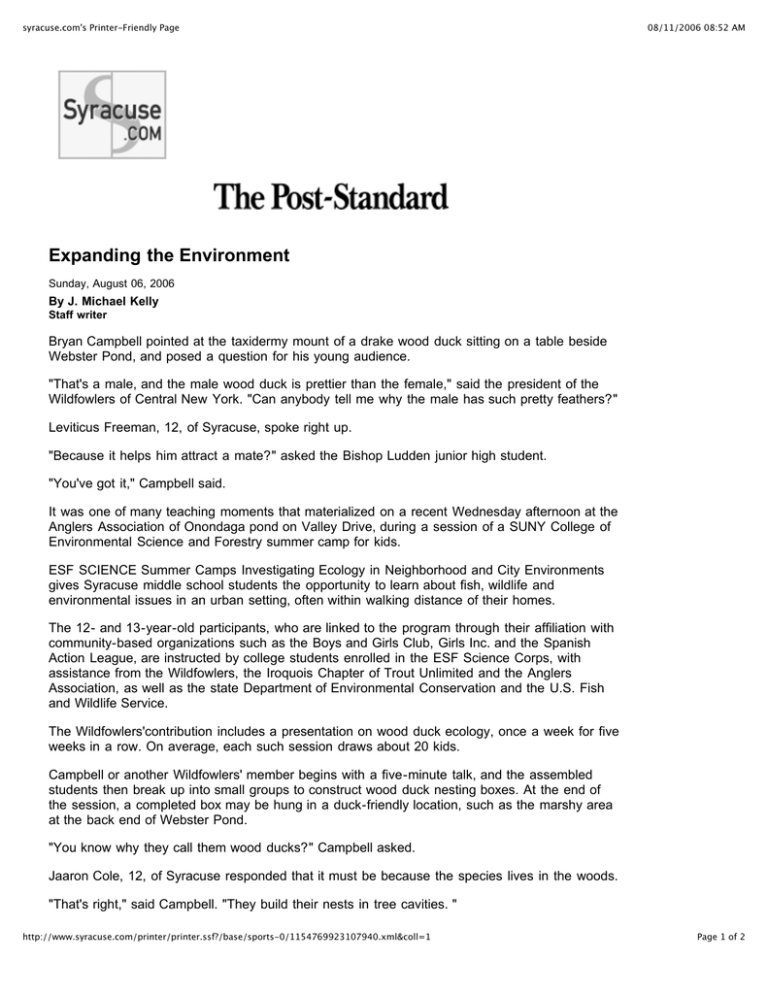
syracuse.com's Printer-Friendly Page
08/11/2006 08:52 AM
Expanding the Environment
Sunday, August 06, 2006
By J. Michael Kelly
Staff writer
Bryan Campbell pointed at the taxidermy mount of a drake wood duck sitting on a table beside
Webster Pond, and posed a question for his young audience.
"That's a male, and the male wood duck is prettier than the female," said the president of the
Wildfowlers of Central New York. "Can anybody tell me why the male has such pretty feathers?"
Leviticus Freeman, 12, of Syracuse, spoke right up.
"Because it helps him attract a mate?" asked the Bishop Ludden junior high student.
"You've got it," Campbell said.
It was one of many teaching moments that materialized on a recent Wednesday afternoon at the
Anglers Association of Onondaga pond on Valley Drive, during a session of a SUNY College of
Environmental Science and Forestry summer camp for kids.
ESF SCIENCE Summer Camps Investigating Ecology in Neighborhood and City Environments
gives Syracuse middle school students the opportunity to learn about fish, wildlife and
environmental issues in an urban setting, often within walking distance of their homes.
The 12- and 13-year-old participants, who are linked to the program through their affiliation with
community-based organizations such as the Boys and Girls Club, Girls Inc. and the Spanish
Action League, are instructed by college students enrolled in the ESF Science Corps, with
assistance from the Wildfowlers, the Iroquois Chapter of Trout Unlimited and the Anglers
Association, as well as the state Department of Environmental Conservation and the U.S. Fish
and Wildlife Service.
The Wildfowlers'contribution includes a presentation on wood duck ecology, once a week for five
weeks in a row. On average, each such session draws about 20 kids.
Campbell or another Wildfowlers' member begins with a five-minute talk, and the assembled
students then break up into small groups to construct wood duck nesting boxes. At the end of
the session, a completed box may be hung in a duck-friendly location, such as the marshy area
at the back end of Webster Pond.
"You know why they call them wood ducks?" Campbell asked.
Jaaron Cole, 12, of Syracuse responded that it must be because the species lives in the woods.
"That's right," said Campbell. "They build their nests in tree cavities. "
http://www.syracuse.com/printer/printer.ssf?/base/sports-0/1154769923107940.xml&coll=1
Page 1 of 2
syracuse.com's Printer-Friendly Page
08/11/2006 08:52 AM
Wooden nest boxes, he explained, substitute for the cavities gouged in tree trunks by feeding
woodpeckers or other wild creatures.
Conservationists, including birders and duck hunters, have built and hung many thousands of
nest boxes since the early 1900s.
Today, several million wood ducks live in the United States and Canada, but by the advent of
World War I, woodies were on the brink of extinction, due to a combination of habitat loss and
market hunting. Restaurants paid top dollar for the tasty birds, and hat-makers coveted their
feathers, which are among the most strikingly colored of all waterfowl plumage.
From 1918 to 1941, it was illegal to kill wood ducks in the United States and Canada, but during
that closed period the birds began a dramatic comeback, as nest boxes sprouted on poles and
tree trunks in countless swamps and along thousands of miles of winding streams.
The boxes assembled by the ESF SCIENCE campers follow the same construction blueprint
that's been in use since the Roaring Twenties. They are roughly two feet tall, a foot wide and 10
inches deep, with an oval entrance hole about four inches high.
"Believe it or not, a wood duck can fly through that hole as fast as we can drive a car and turn
around and face outside almost instantly, without hitting the back wall of the nest," Wildfowlers'
member Aaron Kroll told the kids gathered at Webster Pond.
On the insideof each box, just below that window, Kroll and Campbell fasten a small wire
"ladder" that hatched ducklings can use to climb up and out into the world.
"Their mother pushes them out if they don't jump on their own," Campbell said. He's watched
such exits many times, and said he's never seen one of the little woodies incur an injury when
they hit the ground.
Now and then one of the ESF SCIENCE kids spots a wood duck feather during the stream
ecology part of the summer program, which is held along Furnace Brook in Syracuse's Elmwood
Park.
The brook is a high-quality trout water, and the SCIENCE groups learn about it by turning over
rocks and collecting the aquatic insects, crayfish and other creatures that live underneath. After
that instruction, T.U. members demonstrate fly-casting and whip up a few trout flies some of
which might have wings or tails made from a wood duck's black-barred side feathers.
© 2006 The Post-Standard. Used with permission.
Copyright 2006 syracuse.com. All Rights Reserved.
http://www.syracuse.com/printer/printer.ssf?/base/sports-0/1154769923107940.xml&coll=1
Page 2 of 2


